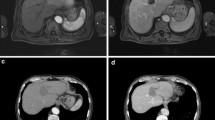Abstract
Purpose
This clinical study was conducted to evaluate the safety and short-term outcomes of irreversible electroporation (IRE) for the treatment of patients with hepatocellular carcinoma (HCC) in Japan.
Materials and methods
The study was designed in a prospective setting. Five patients (3 men and 2 women; mean age, 66.6 ± 5.8 years) with 6 HCCs were enrolled and treated using percutaneous ultrasound (US)-guided IRE. Safety was assessed based on adverse events and laboratory values. Local control was assessed using contrast-enhanced US with a perflubutane microbubble contrast agent, contrast-enhanced multiphase CT, and gadoxetic acid-enhanced MRI (EOB-MRI) at designated points.
Results
The tumors ranged in diameter from 11 to 28 mm (mean diameter, 17.5 ± 6.3 mm). Five of the 6 tumors (83 %) were successfully treated, with no local recurrence to date (mean follow-up 244 ± 55 days). In 1 lesion located in liver segment 1, residual tumor was diagnosed at 7 days after intervention by follow-up EOB-MRI. No serious complications related to the IRE procedure were observed.
Conclusion
The results of this study suggest that image-guided percutaneous IRE can achieve satisfactory local disease control, particularly for small HCCs, and is well tolerated by patients.





Similar content being viewed by others
References
Davalos RV, Mir IL, Rubinsky B. Tissue ablation with irreversible electroporation. Ann Biomed Eng. 2005;33:223–31.
Lee EW, Loh CT, Kee ST. Imaging guided percutaneous irreversible electroporation: ultrasound and immunohistological correlation. Technol Cancer Res Treat. 2007;6:287–94.
Martin RC, Philips P, Ellis S, Hayes D, Bagla S. Irreversible electroporation of unresectable soft tissue tumors with vascular invasion: effective palliation. BMC Cancer. 2014;14:540.
Cheung W, Kavnoudias H, Roberts S, Szkandera B, Kemp W, Thomson KR. Irreversible electroporation for unresectable hepatocellular carcinoma: initial experience and review of safety and outcomes. Technol Cancer Res Treat. 2013;12:233–41.
Martin RC 2nd, McFarland K, Ellis S, Velanovich V. Irreversible electroporation in locally advanced pancreatic cancer: potential improved overall survival. Ann Surg Oncol. 2013;20:S443–9.
Thomson KR, Cheung W, Ellis SJ, Federman D, Kavnoudias H, Loader-Oliver D, et al. Investigation of the safety of irreversible electroporation in humans. J Vasc Interv Radiol. 2011;22:611–21.
Valerio M, Dickinson L, Ali A, Ramachandran N, Donaldson I, Freeman A, et al. A prospective development study investigating focal irreversible electroporation in men with localised prostate cancer: Nanoknife Electroporation Ablation Trial (NEAT). Contemp Clin Trials. 2014;39:57–65.
Kudo M, Izumi N, Kokudo N, Matsui O, Sakamoto M, Nakashima O, et al. HCC Expert Panel of Japan Society of Hepatology. Management of hepatocellular carcinoma in Japan: consensus-based clinical practice guidelines proposed by the Japan Society of Hepatology (JSH) 2010 updated version. Dig Dis. 2011;29:339–64.
International Working Party. Terminology of nodular hepatocellular lesions. Hepatology. 1995;22:983–93.
Cardella JF, Kundu S, Miller DL, Millward SF, Sacks D. Society of Interventional Radiology. Society of Interventional Radiology clinical practice guidelines. J Vasc Interv Radiol. 2009;20:S189–91.
Sugimoto K, Moriyasu F, Kobayashi Y, Imai Y. Assessment of irreversible electroporation ablation zone using Kupffer-phase contrast-enhanced ultrasound (CEUS) images with Sonazoid. J Med Ultrason. 2014;41:531–2.
Sugimoto K, Moriyasu F, Kobayashi Y, Kasuya K, Nagakawa Y, Tsuchida A, et al. Assessment of various types of US findings after irreversible electroporation in porcine liver: comparison with radiofrequency ablation. J Vasc Interv Radiol. 2015;26:279–87.
Guo Y, Zhang Y, Nijm GM, Sahakian AV, Yang GY, Omary RA, et al. Irreversible electroporation in the liver: contrast-enhanced inversion-recovery MR imaging approaches to differentiate reversibly electroporated penumbra from irreversibly electroporated ablation zones. Radiology. 2011;258:461–8.
Qin Z, Jiang J, Long G, Lindgren B, Bischof JC. Irreversible electroporation: an in vivo study with dorsal skin fold chamber. Ann Biomed Eng. 2013;41:619–29.
Moriyasu F, Itoh K. Efficacy of perflubutane microbubble-enhanced ultrasound in the characterization and detection of focal liver lesions: phase 3 multicenter clinical trial. AJR Am J Roentgenol. 2009;193:86–95.
Sugimoto K, Moriyasu F, Shiraishi J, Saito K, Taira J, Saguchi T, et al. Assessment of arterial hypervascularity of hepatocellular carcinoma: comparison of contrast-enhanced US and gadoxetate disodium-enhanced MR imaging. Eur Radiol. 2012;22:1205–13.
Wilson SR, Burns PN. Microbubble-enhanced US in body imaging: what role? Radiology. 2010;257:24–39.
Rhim H, Lee MH, Kim YS, Choi D, Lee WJ, Lim HK. Planning sonography to assess the feasibility of percutaneous radiofrequency ablation of hepatocellular carcinomas. AJR Am J Roentgenol. 2008;190:1324–30.
Kunishi Y, Numata K, Morimoto M, Okada M, Kaneko T, Maeda S, et al. Efficacy of fusion imaging combining sonography and hepatobiliary phase MRI with Gd-EOB-DTPA to detect small hepatocellular carcinoma. AJR Am J Roentgenol. 2012;198:106–14.
Kingham TP, Karkar AM, D’Angelica MI, Allen PJ, Dematteo RP, Getrajdman GI, et al. Ablation of perivascular hepatic malignant tumors with irreversible electroporation. J Am Coll Surg. 2012;215:379–87.
Acknowledgments
This work was supported by MEXT KAKENHI Grant Number 26865030.
Conflict of interest
The authors declare that they have no conflicts of interest.
Author information
Authors and Affiliations
Corresponding author
About this article
Cite this article
Sugimoto, K., Moriyasu, F., Kobayashi, Y. et al. Irreversible electroporation for nonthermal tumor ablation in patients with hepatocellular carcinoma: initial clinical experience in Japan. Jpn J Radiol 33, 424–432 (2015). https://doi.org/10.1007/s11604-015-0442-1
Received:
Accepted:
Published:
Issue Date:
DOI: https://doi.org/10.1007/s11604-015-0442-1




